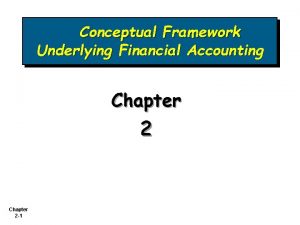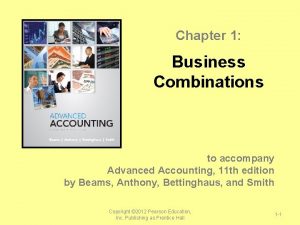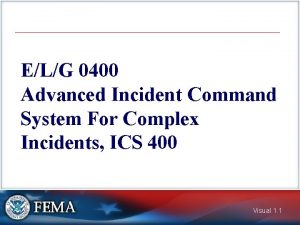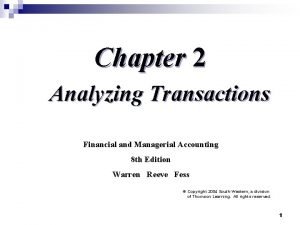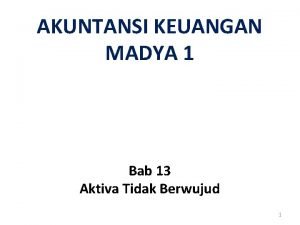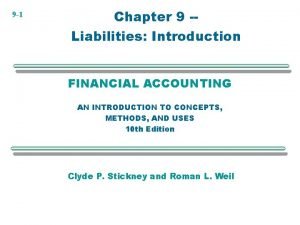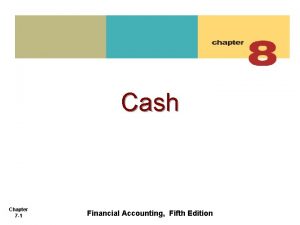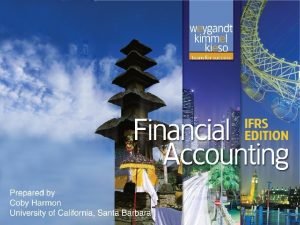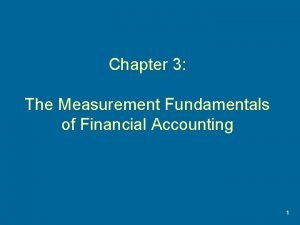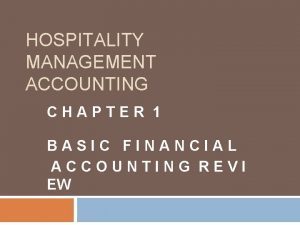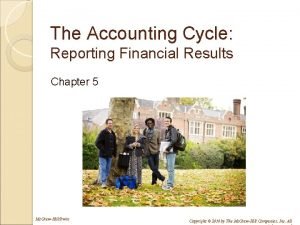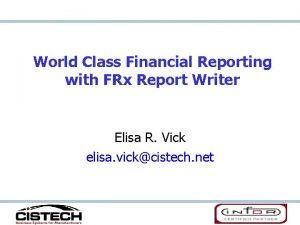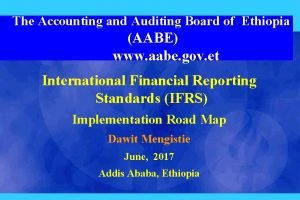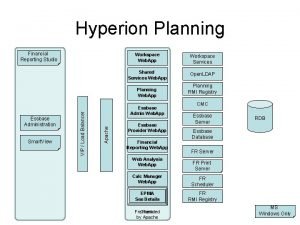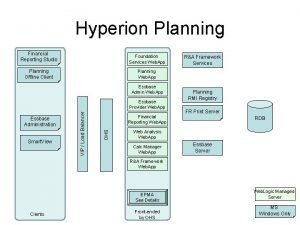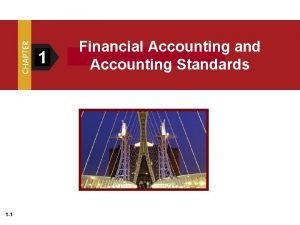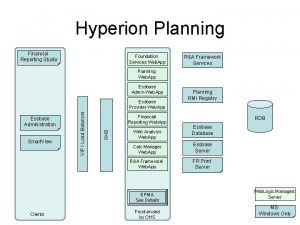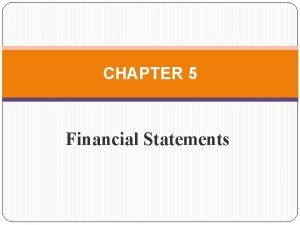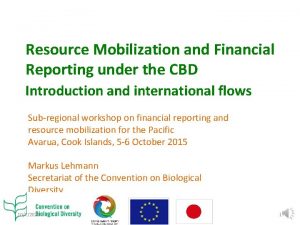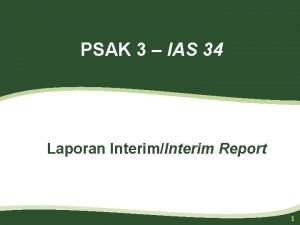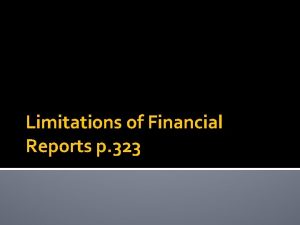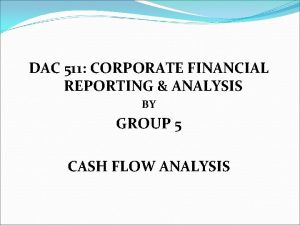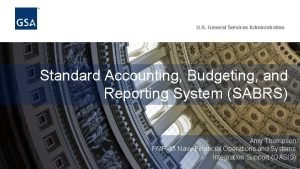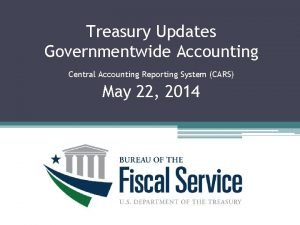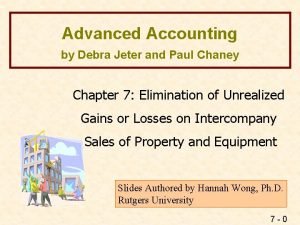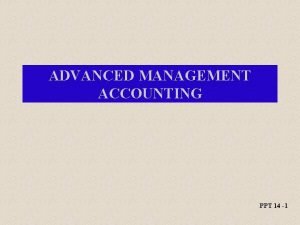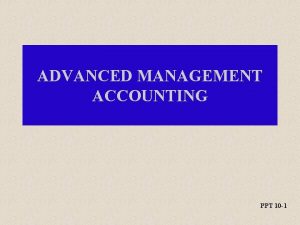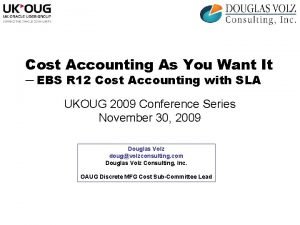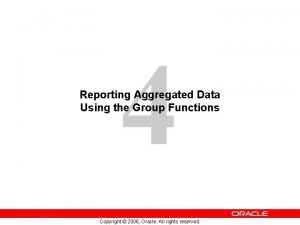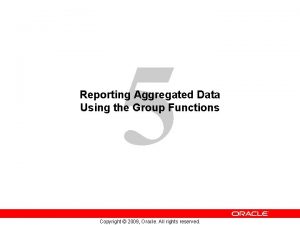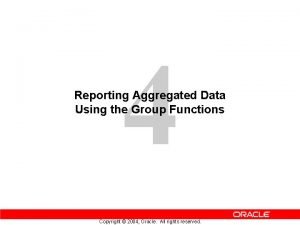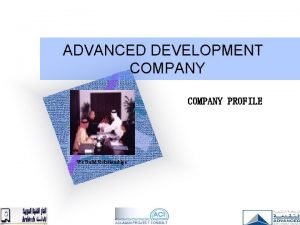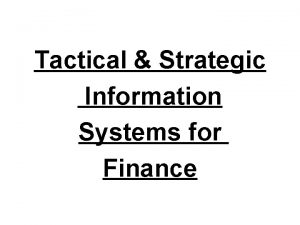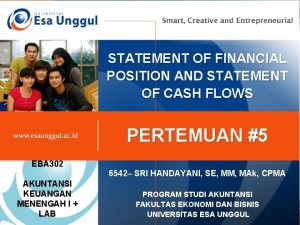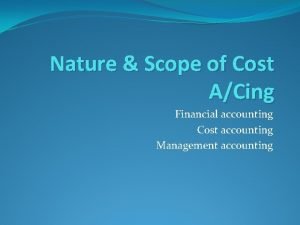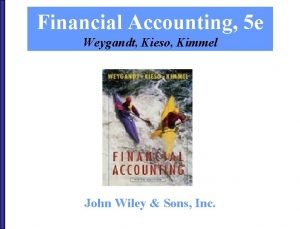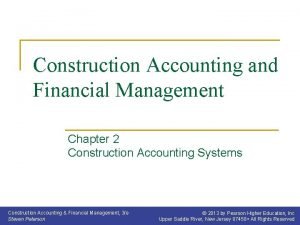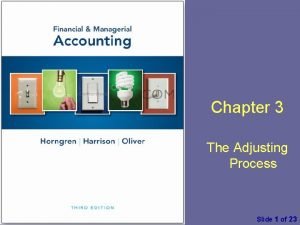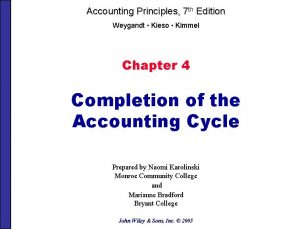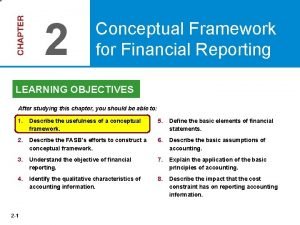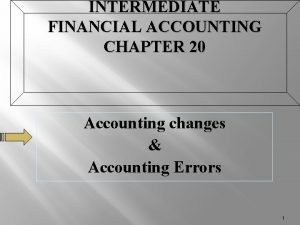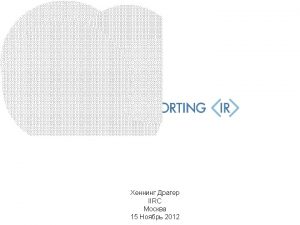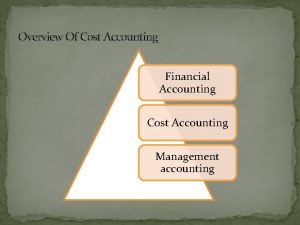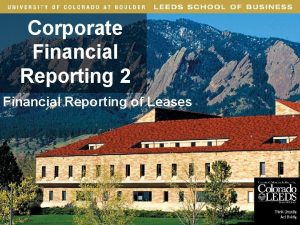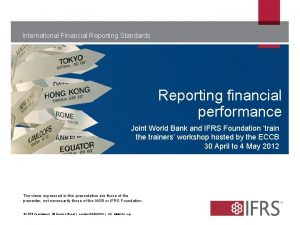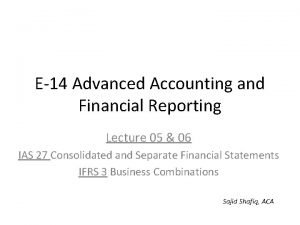Advanced Financial Accounting Chapter 2 Group Reporting I


























































- Slides: 58

Advanced Financial Accounting: Chapter 2 Group Reporting I: Concept and Context Tan, Lim & Lee Chapter 2 © 2015 1

Learning Objectives Understand: 1. The rationale for group reporting and the complementarity of reporting by legal and economic entities, and business units; 2. The economic incentives for the provision of consolidated financial information; 3. The economic context of group reporting – merger and acquisition as risk management strategy and the impact on financial reporting; 4. The concept of “control” and the determination of the parentsubsidiary relationship; 5. The concept of “significant influence” and the notion of “associate” 6. The concept of a “business combination” and the scope of IFRS 3; 7. The theories relating to consolidation; and 8. The effects of parent versus entity theories of consolidation Tan, Lim & Lee Chapter 2 © 2015 2

Content 1. Introduction 2. Economic Incentives for the Preparation of Consolidated Information 3. Economic Motives for Entering into Intercorporate Arrangements 4. The Concept of Control 5. The Concept of Significant Influence 6. Accounting for Business Combinations 7. Consolidation Theories Tan, Lim & Lee Chapter 2 © 2015 3

Introduction • A primary issue that underpins financial reporting is the identification of the reporting entity. Financial information may be reported at three levels Financial information Separate financial statements for the legal entity Tan, Lim & Lee Chapter 2 Aggregated reporting for the economic entity © 2015 Disaggregated reporting for business units within a legal or economic entity 4

Introduction Relationship of control within legal entities • Shared ownership • Contractual or statutory arrangements Legal Entity Individual financial statement Tan, Lim & Lee Chapter 2 Control Effective relationship © 2015 Legal entity Individual financial statement 5

Introduction Incentive to extend economic boundaries Capitalizing on slack debt or operating capacity Increased market shares Tapping on growth opportunities Economies of scale and scope Reduced risk through diversification Tan, Lim & Lee Chapter 2 © 2015 6

Introduction • Principle of substance over form: – Notion of a reporting entity extends beyond the legal entity to that of an economic group of related companies • The need for consolidated financial statements by the reporting entity – If separate financial statements are the only source of information • FS users will not be able to properly assess extent of the size, profitability, cash flows and risks of the larger economic entity • May not be able to obtain a clear picture of group performance as a whole (i. e. not seeing the forest for the trees) – Consolidation FS allows investors to asses the risk-return profile of the combined entity Tan, Lim & Lee Chapter 2 © 2015 7

Introduction • A group of companies better able to deal with economic risk like – – – Macro-economic risk (e. g changes in government policies) Industry risk (e. g. technological risks) Firm-specific risk (e. g. over-reliance on specific human capital) • Corporate acquisition and diversification may be sub-optimal and value-destroying if – Motivate by managers’ self-interest to invest in size rather than value (Jensen, 1986, Shelefier and Vishny, 1990) – Costs and risks that arise from acquisition strategies, particularly in unrelated diversification • Synergistic benefits potentially reduced by direct and indirect costs arising from these strategies Tan, Lim & Lee Chapter 2 © 2015 8

Introduction • Corporate regulations may require separate financial statements to be prepared by each legal entity Purpose of separate Financial Statements Provide information for legal and tax purposes Tan & Lee Chapter 2 Determine the financial solvency of individual entities © 2015 Prevent weakness of individual companies to be masked by strengths of other group companies 9

Introduction Need for disaggregated Information Loss of information if only aggregated information is provided Source of disaggregated information Separate financial statements Segment information Determine risk profile of individual segments Tan, Lim & Lee Chapter 2 Strength and weaknesses of specific operation and geography 10

Introduction Parent-Subsidiary Relationship Subsidiary Group l C Parent (Controlling entity) ro ont Control Co Subsidiary ntro l Subsidiary Tan, Lim & Lee Chapter 2 © 2015 Consolidation: Process of preparing and presenting financial statements of parent and subsidiary as if they were one economic entity Consolidated FS: Artificial creations 11

Content 1. Introduction 2. Economic Incentive for the Preparation of Consolidated Information 3. Economic Motives for Entering into Intercorporate Arrangements 4. The Concept of Control 5. The Concept of Significant Influence 6. Accounting for Business Combinations 7. Consolidation Theories Tan, Lim & Lee Chapter 2 © 2015 12

Information Perspective • Managers with a comparative advantage on information about their firms are compensated for their ability to provide information on the future cash flows of these firms (Holthausen and Leftwish, 1983) Are consolidated financial statements more informative than separate financial statements? Tan, Lim & Lee Chapter 2 No (Mian and Smith, 1990) Investors can duplicate “homemade” consolidated financial statements [Assumption: intragroup transactions are small] Yes (Holthausen, 1990) The greater the interdependencies among group companies, the more informative combined earnings about future cash flows of the combined entity © 2015 13

Information Perspective • According to Mian and Smiths’ views, a firm is more likely to choose consolidated reporting when: – – There are greater interdependencies between parent and subsidiaries Foreign rather than domestic subsidiaries Parent provides direct guarantee of the subsidiary’s debt Parent is in the financial services industry • Under Holthausen’s view: – The greater the interdependencies among the group companies, the higher the likelihood of intragroup transactions – Difficult for external users to replicate the consolidation process – Managers have incentives to voluntarily provide consolidated FS that will enable investors to better predict group’s future cash flows Tan, Lim & Lee Chapter 2 © 2015 14

Efficient Contracting • Whittred (1987) suggests that consolidated information improves wealth for firms • Reason: reduced information asymmetry between lenders and borrowers – Lenders fear that borrowers will transfer assets to related companies – Borrowers expropriate a considerable larger sum than what they stand to lose because of limited liability • Hence, lenders required cross-guarantees issued by parent companies. Whittred suggests a set of consolidated financial statements performs the same function as a “cross guarantee” • Hence, a set of consolidated FS performs the same function as a “crossguarantee issued by a parent company – Undo the effect of separately incorporated companies within the group (e. g. if Sub A is not able to pay its debt as legal entity, its shortfall is compensated by net assets of other entities within the group [“Co-insurance” effect]) – Implicit assurance to lenders that debt is financially backed by assets of combined entity Tan, Lim & Lee Chapter 2 © 2015 15

Opportunism • Consolidated financial statements lead to wealth transfers to managers at the expense of other stakeholders if the acquisition is motivated by managerial self-interest – Managers enjoy higher compensation, perks and power through managing a larger group of companies sheer increase in size will result in higher pay out for managers notwithstanding their competency. – Managers are more likely to over-invest in companies that are specific and complementary to their skills (Shleifer and Vishny, 1990) • Information asymmetry may arise by masking financial problems of individual companies within the group • Conclusion: Both aggregated (consolidated) and disaggregated (segment) information are required Tan, Lim & Lee Chapter 2 © 2015 16

Content 1. Introduction 2. Economic Incentive for the Preparation of Consolidated Information 3. Economic Motives for Entering into Intercorporate Arrangements 4. The Concept of Control 5. The Concept of Significant Influence 6. Accounting for Business Combinations 7. Consolidation Theories Tan, Lim & Lee Chapter 2 © 2015 17

Economic Incentives for Entering into Intercorporate Arrangements Markets will not reward firm’s diversification with a higher price for its shares if investors can replicate the firm’s strategies Sub-optimal consequence Corporate Diversification Other reasons Why Corporate Diversification? • Individuals not able to diversify as efficiently because of indivisibility of assets and high transaction costs (i. e. to achieve economies of scale) Tan, Lim & Lee Chapter 2 • Firms involved in M&A have stakeholders (i. e. managers and employees) who are not able to diversify their risks as well as shareholders • Corporate diversification may mitigate the problem of under-investment by riskaverse managers © 2015 18

Economic Incentives for Entering into Intercorporate Arrangements Acquirer gains “control” over the operating and financial policies of the acquiree (Consolidation) Two or more acquirers gain “joint-control” over the acquiree (Joint venture) Arrangements in M&A Reciprocal investments are held by each of the two firms, as both are deemed to be equally dominant (Pooling of interests) Tan, Lim & Lee Chapter 2 Acquirer has “significant influence” over the operating and financial policies of the acquiree (Equity accounting) © 2015 19

Economic Incentives for Entering into Intercorporate Arrangements Risk mitigated by M&A strategies Uncertainty Risk management strategies • Organic growth or acquisition • Risk diversification Information Control (Acquisition method) Tan, Lim & Lee Chapter 2 Joint-venture (Equity accounting) © 2015 Value • Combined risks • Size effects • Co-insurance effect • Diversification effect Significant Influence (Equity accounting) 20

Investing Strategies, Ownership Levels and the Impact on Financial Reporting Continuum of intercorporate ownership (under previous accounting standards such as IAS 27, IFRS 12, IAS 28, IFRS 13 and IAS 31) Zero Ownership 20% Ownership Passive Investment p u r p o s e ii. Earn dividend income Make capital gain Tan, Lim & Lee Chapter 2 100% Ownership Active Investment • Associated company • Jointventure • Trading securities • Availablefor-sale securities i. 50% Ownership i. Exert significant influence or control over investee’s operation © 2015 • Partially-owned subsidiary • Fully-owned subsidiary i. iii. Gain entry intro a new market Achieve synergistic benefits from complementary strengths Gain market dominance 21

Investing Strategies, Ownership Levels and the Impact on Financial Reporting • New accounting standards – – • IFRS 10: Consolidated Financial statements Revised IAS 27: Separate Financial statements IAS 28 Investments in Associates and Joint Ventures IFRS 11: Joint Arrangements Definition of control Under old IAS 27 IFRS 10 Control is determined by the following: 1. Power to govern financial and operating policies 2. Benefits derived therein, or risk and rewards Investor controls an investee when: 1. It is exposed, or has rights to the variable returns from an investee 2. Has power over investee and ability to affect those returns 3. Relevant facts and circumstances Tan, Lim & Lee Chapter 2 © 2015 22

Content 1. Introduction 2. Economic Incentive for the Preparation of Consolidated Information 3. Economic Motives for Entering into Intercorporate Arrangement 4. The Concept of Control 5. The Concept of Significant Influence 6. Accounting for Business Combinations 7. Consolidation Theories Tan, Lim & Lee Chapter 2 © 2015 23

The Concept of Control Power to govern the financial and operating policies of an entity so as to obtain benefits from its activities (IAS 27: 4) Power to decide on the financial and operating policies of an entity Enjoy the benefits from the exercise of the power Example of a scenario where there is no control: Agent or trustee acting on behalf of a beneficiary Tan, Lim & Lee Chapter 2 © 2015 24

The Concept of Control under old IAS 27 Determination of control Ownership of more than 50% of voting power: Control is presumed to exist when the parent owns directly or indirectly through subsidiaries, more than one-half of the voting power of an entity unless, in exception circumstances, it can be clearly demonstrated that such ownership does not constitute control ( *note: use of quantitative criterion is only a guide) Ownership of less than 50% of voting power but there is : a) Power over more than one-half of the voting rights arising from an agreement with other investors; or b) Power to govern the financial and operating policies of an entity arising from a statute or an agreement; or c) Power to appoint or remove the majority of the members of the board of directors or equivalent governing body; or d) Power to cast the majority of votes at meetings at the board of directors or equivalent governing body that has control over the entity Control Subsidiary 25

The concept of control under IFRS 10 • Under IFRS 10, the following qualitative factors are set out to determine if investor has control Power Control Ability Returns Tan, Lim & Lee Chapter 2 © 2015 26

The concept of control under IFRS 10 • Determining Power – The sources of power could be • Existing rights obtained from shares’ voting rights • Management contractual arrangements • Potential voting rights via ownership of convertibles and share options • Control over key management • Control over entity that directs the investee’s relevant activities • Special relationships that could indicate control over investee (e. g. investee’s key management are current or former employees of investor) – Rights of minority shareholders need to be considered – The purpose and design of investee should be considered to identify relevant activities and decisions over those activities to assess control • Relevant activities include operating and financial activities • Decisions over those activities include operating and capital decisions of investee and appointment etc. Tan, Lim & Lee Chapter 2 © 2015 27

The concept of control under IFRS 10 • • • Determining Power (continued) – Investors need to consider which relevant activity most significantly affects the investee’s return when two investors each control relevant activities Ability – Investor must have: • Substantive rights (i. e. practical ability to exercise those rights) • Unilateral ability to direct the most significant activities • NOT be acting as an agent – The ability to use the power must be current even though it need not be currently exercisable – Little barriers that prevent the exercise of those rights – Investors holding the rights must benefit from exercising those rights Returns – Variable returns that investors is exposed to could be (i) all positive (ii) all negative (iii) either positive or negative Tan, Lim & Lee Chapter 2 © 2015 28

The concept of control under IFRS 10 • Examples: 1. Investor owns 46% in investee but 54% remaining shares are dispersed among many investors • Conclusion: investor has sufficient dominant voting interest (de facto control) to meet power criterion 2. Investor holds 46% shares, while two other investors own 27% each. • Conclusion: the two investors hold relatively more voting rights than investor holding 46% 3. Investor holds 45% interest, while five investors individually hold 11% interest • Conclusion: investor has contractual right to appoint, remove and set remuneration of key management of investee power over investee Tan, Lim & Lee Chapter 2 © 2015 29

Direct and Indirect Control • • For the test of control, IAS 27 requires consideration of the percentage of voting rights held “direct or indirectly through subsidiaries” Control must be demonstrated at each intermediate level before the ultimate holding company is said to have control over the lowest-level company Affiliation structures X Co. 100% Y Co. 50% B Co. 60% Z Co. Situation 1: X Co. controls Y Co. and A Co. Even though X. Co. indirectly owns 75% Break in control at B and hence no control over Z Co. A Co. Situation Tan, Lim & Lee Chapter 2 1 60% Y Co. 55% 60% B Co. Z Co. 40% 50% © 2015 Situation 2: X Co. controls Y Co. , B Co. and Z Co. Does not own A Co. (<51%) X Co. Situation 2 50% A Co. 30

Legal Ownership versus Effective Control • IAS 27 is principles-based, and all evidence must be considered for the existence of control – Legal ownership is not the only criterion for determining the existence of control (> 50%) – Power to govern operating financial policies – Obtain benefits from activities of the other entity • Steps in consolidation (IAS 27) – 1 st: Determine if control exists through the levels of investment holding – 2 nd: Once control is established, determine the economic boundaries of the group and consolidation procedures that should be applied to combined the FS of parent and subsidiaries – 3 rd: Use the effective percentage ownership to determine the non-controlling interests’ share (further discussed in chapter 4) Tan, Lim & Lee Chapter 2 © 2015 31

Potential Voting Rights in the Determination of Control • IAS 27 and IFRS 10 requires potential voting rights, which are currently exercisable or convertible, to be considered when determining the existence of control • IAS 27: 14: Potential voting rights arise from “share warrants, share call options, debt or equity instruments that are convertible into ordinary shares, or other similar instruments that have the potential, if exercised or converted, to give the entity voting power or reduce another party’s voting power over the financial and operating policies of another entity – In IFRS 10: potential voting rights (must be substantive) is a factor to consider in determining if investor has power, and hence control over investee • IAS 27: 15: In determining whether potential voting rights contribute to control, the investor examines all facts and circumstances, such as terms of exercise of the potential voting rights and any other contractual terms such as exercise price and date • It is important that the potential voting rights must be currently exercisable or convertible to be included in the test of control Tan, Lim & Lee Chapter 2 © 2015 32

Potential Voting Rights in the Determination of Control Illustration of potential voting rights Issued ordinary shares Percentage of ordinary shares Issued share warrants Potential shares from warrants Total shares Percentage (issued and of total potential) shares Company A $10, 000 50% $5, 000 $10, 000 $20, 000 62. 50% Other investors 10, 000 50% 1, 000 2, 000 12, 000 37. 50% Total $20, 000 100% $6, 000 $12, 000 $32, 000 100. 00% • Although Company A owns only 50% of the total issued ordinary shares, its holding of the share warrants gives it de facto control over Company B. • If company A wishes, it can exercise its share warrants immediately and assume 62. 5% ownership over Company B. Tan, Lim & Lee Chapter 2 © 2015 33

Potential Voting Rights in the Determination of Control Situations where potential voting rights may determine control When one investor has the right to increase its voting power or reduce other investors’ voting power Currently exercisable share options even though they are currently “out of the money” Tan, Lim & Lee Chapter 2 © 2015 34

Impact of Potential Voting Rights on the Allocation of Profit • Potential voting rights that are currently exercisable or convertible are considered in determining control BUT excluded in determination for allocation of profit to parent and NCI • IAS 27: 19: The proportion of profit or loss and changes in equity allocated to the parent and non-controlling interests are determined on the basis of present ownership interests and do not reflect the possible exercise or conversion of potential voting rights”. • However, if the potential voting rights, in substance, gives the holder access at present to the economic benefits associated with an ownership interest should be considered( IAS 27: IG 5 -6) • Generally, the holding of option, warrant, debt or equity instrument does not give the holder a present right to the economic benefits arising from actual ownership of shares Tan, Lim & Lee Chapter 2 © 2015 35

Principal-agent Relationships • An investor is an agent when he exercises power on behalf of another investor (IFRS 10) – Agent does not control investee and does not need to consolidate investee • Factors to consider if an investor is a principal or agent (IFRS 10): – – – • Rights of other parties Principal’s exposure to variable returns from other interests held Scope of decision making authority of the principal Remuneration entitled by principal Principal’s rights to remove the decision maker without cause Determining de facto agents – Need not be contractual relationships between parties and investors – Examples include: (i) related parties of investor, (ii) parties with close business relationships, (iii) parties that receive interest in investee as loan from investor and (iv) parties whose key management are same as that of investor Tan, Lim & Lee Chapter 2 © 2015 36

Content 1. Introduction 2. Economic Incentive for the Preparation of Consolidated Information 3. Economic Motives for Entering into Intercorporate Arrangement 4. The Concept of Control 5. The Concept of Significant Influence 6. Accounting for Business Combinations 7. Consolidation Theories Tan, Lim & Lee Chapter 2 © 2015 37

The Concept of Significant Influence • An investor may participate in the policy-making processes of an investee, although they may not have the power to govern the final outcome of decision-making process • IAS 28 describes such an investor as having “significant influence”, and the investee is deemed an “associate” of the investor • Special accounting procedures described as the “equity method” are applied Tan, Lim & Lee Chapter 2 © 2015 38

What is Significant Influence? Significant influence Power to participate in the financial and operating policy decisions of the investee but is less than control and is not equivalent to joint control over those policies (IAS 28: 2) Default assumption: An investor has ownership of 20% or more of the voting power and equal to or less than 50% of the voting power in an investee, including “potential voting rights” Other evidences (IAS 28: 7) Number of directors representing investors on board Participation in policy-making processes Operational interdependencies Investor must disclose reasons for not complying with default assumption Tan, Lim & Lee Chapter 2 © 2015 39

Definition of associate • “An associate is an entity in which the investor has significant influence and which is neither a subsidiary nor a joint-venture of the investor” (IAS 28: 2) • If investee is an associate, the investor is not referred to as the “parent” – “parent” applies only to relationships where investor has control over investee Tan, Lim & Lee Chapter 2 © 2015 40

Direct and Indirect Significant Influence Multi-level structures P 80% 50% X 50% Y 50% Situation 1: P has significant influence over: i) Y (50% direct interest) ii) Z (65% indirect interest) – P has no control over Y P 40% 50% A 80% Z Situation 1 Tan, Lim & Lee Chapter 2 C 20% Situation 2: P has significant influence over: i) A (40% direct interest) ii) C (50% direct interest) iii) B (42% indirect interest) B Situation 2 © 2015 41

Content 1. Introduction 2. Economic Incentive for the Preparation of Consolidated Information 3. Economic Motives for Entering into Intercorporate Arrangement 4. The Concept of Control 5. The Concept of Significant Influence 6. Accounting for Business Combinations 7. Consolidation Theories Tan, Lim & Lee Chapter 2 © 2015 42

Accounting for Business Combinations Standards relevant to the preparation and presentation of consolidated financial statements IFRS 3 Business Combination (deals with business combination generally) IAS 27 Consolidated and Separate Financial Statements ( applies specifically to the preparation and presentation of consolidated financial statements for parent-subsidiary combinations) Tan, Lim & Lee Chapter 2 © 2015 43

Overview of the Scope of the IFRS 3 • Objective of IFRS 3 – Specify the requirements governing the method of accounting, disclosure and presentation of the financial statements of a reporting entity comprising one or more separate entities that are brought together in a business combination Purchasing the equity of another entity Purchasing the net assets of another entity Business combinations result from Assuming the liabilities of another entity Tan, Lim & Lee Chapter 2 Purchasing some of the net assets of another entity that together form one or more business © 2015 44

Purchase of Net Assets versus Purchase of Equity Parent Acquirer Acquires controlling interest in equity of Buys over net assets Subsidiary • • • Acquiree Parent – Subsidiary relationship Separate legal entities - separate FS Single reporting entity - Consolidated FS Tan, Lim & Lee Chapter 2 • • • © 2015 No Parent – Subsidiary relationship One legal and economic entity Do not require consolidated financial statements 45

Content 1. Introduction 2. Economic Incentive for the Preparation of Consolidated Information 3. Economic Motives for Entering into Intercorporate Arrangement 4. The Concept of Control 5. The Concept of Significant Influence 6. Accounting for Business Combinations 7. Consolidation Theories Tan, Lim & Lee Chapter 2 © 2015 46

Consolidation Theories • Theories relating to consolidation are critical when the percentage of ownership in a subsidiary is less than 100% • Termed “partially owned subsidiary”, where the remaining percentage is owned by shareholders who are collectively referred to as “non-controlling interest” (NCI) Parent Non-controlling interests 90% 10% Subsidiary Both parent and non-controlling interest have a proportionate share of the subsidiary’s: • • Net profit; Dividend distribution; Tan, Lim & Lee Chapter 2 • • Share capital Retained profits and changes in equity © 2015 47

Consolidation Theories Parent company sells part of its stake in a subsidiary to external shareholders Parent company buys a majority stake in a subsidiary from existing owners Tan, Lim & Lee Chapter 2 Reasons why non-controlling interest Parent and non-controlling arise shareholders are founding shareholders of newly incorporated entity © 2015 48

Consolidation Theories Ownership of the combined entity involving a wholly owned subsidiary Joint-ownership of the combined entity involving a partially owned subsidiary Parent company’s shareholders Parent company 100% ownership Non-controlling shareholders of a subsidiary Subsidiary Wholly owned by the parent company’s shareholders Tan, Lim & Lee Chapter 2 30% ownership in subsidiary Parent company 70% ownership Subsidiary 2 groups of shareholders 1) The parent company’s shareholders; and 2) The non-controlling shareholders of the subsidiary © 2015 49

Comparison of issues Issues Who are the primary users of the consolidated financial statements? How should noncontrolling interests be reported in the consolidated balance sheet? Tan, Lim & Lee Chapter 2 Entity Theory Both non-controlling interest and majority shareholders Shown as equity in BS based on: Consolidated equity = Consolidated assets Consolidated liabilities © 2015 Parent Theory Parent company shareholders Shown as equity in BS based on: Consolidated equity + NCI = Consolidated assets Consolidated liabilities 50

Comparison of issues Issues Entity Theory Should net assets of the subsidiary acquired be shown at full fair values or at the parent’s share of the fair value? Fair value of net assets of subsidiary at date of acquisition reported in full Do non-controlling shareholders have a share of goodwill? Goodwill = asset of economic unit, and reflected in full How should net profit of partially-owned subsidiary be reported? Tan, Lim & Lee Chapter 2 Reported in full as accruing to both majority and NCI © 2015 Parent Theory NCI net assets of subsidiary at date of acquisition shown at book value Asset of parent and restricted to parent’s share NCI’s share of current profit is a deduction of final profit 51

Summary of differences Attributes Entity Theory Parent Theory Fair value differences in relation to identifiable assets and liabilities at date of acquisition Recognized in full, reflecting both parent’s and NCI’s share of fair value adjustments Recognized only in respect of parent’s share Presentation of NCI As part of equity Neither as equity or debt Goodwill is an entity’s asset and should be recognized in full as at date of acquisition Goodwill is parent’s asset Tan, Lim & Lee Chapter 2 © 2015 52

Proprietary Theory • Relevant to accounting for joint-ventures • Parent seen as having a direct interest in a subsidiary’s assets and liabilities – Resulting in proportional or pro-rata consolidation (parent’s interest is directly multiplied to each individual asset or liability of subsidiary and combined with parent’s assets and liabilities). Tan, Lim & Lee Chapter 2 © 2015 53

The Implicit Consolidation Theory Underlying IFRS 3 • Previously, IAS 22 allowed an acquirer to either recognize or ignore non-controlling interests’ share of fair value adjustments of a subsidiary’s identifiable assets and liabilities (mix of parent and entity theories) • IFRS 3 (2008) permits the recognition of non-controlling interests’ share of goodwill • Movement towards the full entity theory – IFRS 3 (2008) permits the inclusion of NCI’s share of goodwill as at date of acquisition – FASB through SFAS 141 requires the recognition of the NCI’s share of goodwill Tan, Lim & Lee Chapter 2 © 2015 54

Illustration 1: Parent versus Entity Theory Scenario • P Co purchased 80% interest in S Co on 1/1/20 x 1 • Consideration transferred: $1, 200, 000 • NCI: 20% • BV of equity of S Co at acquisition date (1/1/20 x 1): $1, 200, 000 • (FV – BV) of property: $100, 000 (Ignore tax effect and depreciation) • FV of NCI: $300, 000 • BV of equity of S Co at 31/12/20 x 1: $1, 270, 000 • Net profit after tax (NPAT) of S Co: $ 70 • Net profit after tax (NPAT) of P Co: $350 Tan, Lim & Lee Chapter 2 © 2015 55

Illustration 1: Parent versus Entity Theory Net profit after tax and NCI Parent theory NCI’s share of net profit is after tax completed as follows: = 20% x S’s net profit after tax = 20% x $70 = $14 Entity Theory NCI are not shown as a deduction but included in entity-wide NPAT. Disclosure is made of the amount of NPAT that relates to NCI = (100% x P’s NPAT) + (80% x S’s NPAT) = (100% x $350) + (80% x $70) = $406 Tan, Lim & Lee Chapter 2 © 2015 56

Illustration 1: Parent versus Entity Theory Good will Parent Theory Goodwill = Investment in S – P’s ownership % X (FV of S’s identifiable net assets at date of acquisition) = $1, 200 – (80% x $1, 300) = $160 Entity theory Parent’s share of goodwill = $160 NCI’s share of goodwill = Fair value of NCI – share of FV of identifiable net assets = $300 – (20% x $1, 300) = $40 Tan, Lim & Lee Chapter 2 © 2015 57

Illustration 1: Parent versus Entity Theory Presentation of NCI Parent Theory Non-controlling interests are shown separately from equity Non-controlling interests = Non-controlling interest % x BV of S’s equity = 20% x $1, 270 = $254 Entity Theory Non-controlling interests are deemed to have an equity interest and are thus presented as a component in equity Non-controlling interests = Non-controlling interest % x (BV of S’s equity + FV adjustments) + NCI’s share of goodwill = 20% x ($1, 270 + $100) +$40 = $314 Tan, Lim & Lee Chapter 2 © 2015 58
 Financial accounting chapter 1
Financial accounting chapter 1 Limitations of responsibility accounting ppt
Limitations of responsibility accounting ppt Chapter 2 conceptual framework for financial reporting
Chapter 2 conceptual framework for financial reporting Chapter 2 conceptual framework
Chapter 2 conceptual framework Fair value historical cost
Fair value historical cost Advanced accounting chapter 1
Advanced accounting chapter 1 Complex incident
Complex incident Managerial accounting chapter 2 solutions
Managerial accounting chapter 2 solutions Financial accounting chapter 13
Financial accounting chapter 13 Financial accounting chapter 6
Financial accounting chapter 6 Financial accounting chapter 9
Financial accounting chapter 9 Financial accounting chapter 7
Financial accounting chapter 7 Financial accounting ifrs 4th edition chapter 12
Financial accounting ifrs 4th edition chapter 12 Financial accounting chapter 3
Financial accounting chapter 3 Chapter 2 test a accounting answer key
Chapter 2 test a accounting answer key Hotel management accounting
Hotel management accounting Financial accounting chapter 5
Financial accounting chapter 5 Frx report writer
Frx report writer Accounting and audit board of ethiopia
Accounting and audit board of ethiopia The purpose of financial statements
The purpose of financial statements Hyperion financial reporting studio
Hyperion financial reporting studio What is financial reporting studio?
What is financial reporting studio? The major key players on the international side are the
The major key players on the international side are the What is financial reporting studio?
What is financial reporting studio? Fge financial management
Fge financial management Cbd financial reporting framework
Cbd financial reporting framework Ias 34 interim financial reporting
Ias 34 interim financial reporting Project management financial reporting
Project management financial reporting Limitations of annual reports
Limitations of annual reports Corporate financial reporting and analysis
Corporate financial reporting and analysis International financial reporting standards 9
International financial reporting standards 9 Limitations of financial reporting
Limitations of financial reporting Sabrs smarts
Sabrs smarts What is ad hoc reporting in accounting
What is ad hoc reporting in accounting Central reporting system
Central reporting system Debra jeter
Debra jeter Introduction to managerial accounting ppt
Introduction to managerial accounting ppt Advanced cost and management accounting ppt
Advanced cost and management accounting ppt Oracle advanced cost accounting
Oracle advanced cost accounting Reporting aggregated data using the group functions
Reporting aggregated data using the group functions Reporting aggregated data using the group functions
Reporting aggregated data using the group functions Reporting aggregated data using the group functions
Reporting aggregated data using the group functions Group policy change management
Group policy change management Advanced development group
Advanced development group Advanced research group
Advanced research group Examples of non financial methods of motivation
Examples of non financial methods of motivation Tactical accounting and financial information system
Tactical accounting and financial information system Statement of financial position account form
Statement of financial position account form 8 scope of management accounting
8 scope of management accounting Nature and scope of cost accounting
Nature and scope of cost accounting Management accounting nature and scope
Management accounting nature and scope Kimmel accounting 5e
Kimmel accounting 5e Construction accounting and financial management
Construction accounting and financial management Income statement in financial accounting
Income statement in financial accounting Unit 5 lesson 2 financial accounting
Unit 5 lesson 2 financial accounting Unit 5 lesson 2 financial accounting
Unit 5 lesson 2 financial accounting Kimmel financial accounting 7the edition
Kimmel financial accounting 7the edition Financial accounting conceptual framework
Financial accounting conceptual framework Father of financial accounting
Father of financial accounting




